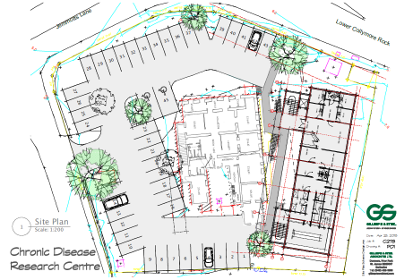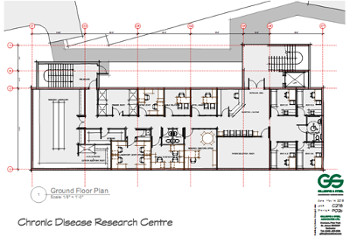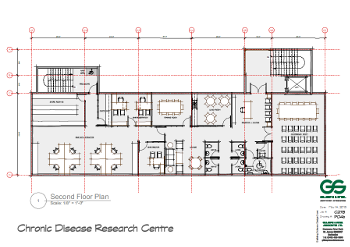Plans for the new "Population Health Sciences Building" have been prepared by Bruce Jardine, architect at Gillespie & Steel Associates Ltd., Prior Park, St. James. Bruce has experience working with the University, including as lead architect for the Faculty of Medical Sciences Teaching Complex on the campus. Importantly, that building included design and construction of a cutting edge research laboratory, a requirement for the new building. Town and Country planning permission has been sought at the date of printing.
Site plan
|
|
 |
The Site Plan shows the new building positioned to the East of the historic GA-CDRC building, which will not be demolished. Plans have been drawn up with the approval of the National Trust. The two buildings will be connected through a first floor bridge, entering through the 1970s wing of the existing GA-CDRC building; hence, no rubble stone walls or roof to the existing GA-CDRC building will be affected.
|
Floor Plan
Ground Floor
|
|
 |
The Ground Floor will house patient examination and education facilities, the reception area, laboratory, and administrative hub of the building, including the offices for the GA-CDRC director, administrative assistant, research manager, and public relations officer.
|
First Floor
|
|
 |
The First Floor will house the heart of the collaboration, featuring offices for seven GA-CDRC academic staff and six Public Health staff (including the Public Health chair and administrative assistant) arranged around a central open plan area serving as the project hub. MPH students will be accommodated across the bridge on the first floor of the existing GA-CDRC building.
|
Second Floor
|
|
 |
The Second Floor will house the BNR, which provides routine surveillance and monitoring for chronic diseases, seminar room, kitchen and coffee area. The roof will accommodate a 20 kW solar electricity array.
|
Sustainable Development
The new "Population Health Sciences Building" must be sustainable, both from a perspective of environmental impact and economic sustainability. The new building is underpinned by a philosophy of energy efficiency, clean technology and a commitment to recycling.
Environmental impact
The environmental impact of the building will be mitigated through adoption of the following green technologies:
Economic sustainability
The economic sustainability of the new building rests on two pillars:
Read/Download Prospectus

Read/Download our 25th anniversary prospectus
- smart rooms, that will switch off lighting and air conditioning when not occupied
- centralized air conditioning, for improved efficiency and ease of service
- installation of a 20kW solar array, to mitigate carbon based energy usage and utility bills
- dual flush toilets, to minimize water consumption and utility bills
- appointment of a recycling officer
- mandatory recycling of paper, printer cartridges, bottles and plastics
- the proven ability of academic staff over the course of two and a half decades to raise extra- mural project grants to sustain high levels of research, employment and training activity
- cost recovery through leasing of the ground floor of the existing GA-CDRC building on a commercial basis (eg as doctor’s offices or other paramedical services) consistent with the vision of the centre












